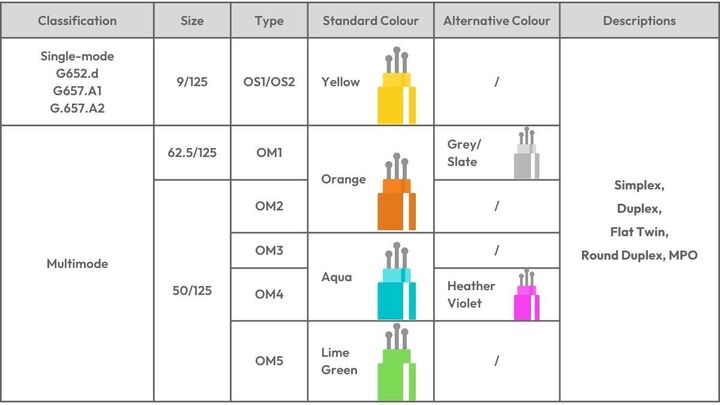Overview of Single-mode vs Multimode Fibre Optic Cables
Core Diameter: Single-mode fibre features a significantly smaller core diameter compared to multimode fibre. Typically, Single-mode has a core diameter of 9μm, while Multifibre typically ranges from 50μm to 62.5μm. The smaller core diameter of Single-mode fibre minimises attenuation, as light passing through experiences fewer reflections, maintaining signal integrity.
Wavelength & Light Source: Multimode fibre, with its larger core size, commonly utilises low-cost light sources such as LEDs and VCSELs, operating at wavelengths of 850nm and 1300nm. In contrast, Single-mode fibre often employs lasers or laser diodes emitting light at wavelengths of 1310nm and 1550nm, offering higher performance and reliability.
Bandwidth: Multimode fibre bandwidth is limited by its transmission modes, with current maximum bandwidth reaching 28000MHz*km for OM5 fibre. Single-mode fibre, theoretically, has
unlimited bandwidth as it allows only one light mode to propagate at a time, ensuring consistent and high-speed data transmission.
Transmission Distance & Cost: Single-mode fibre offers longer transmission distances compared to Multimode fibre, especially at higher data rates such as 40G and 100G. While Single-mode transceivers may incur higher upfront costs, the overall installation cost could be lower due to reduced labour expenses and longer-lasting infrastructure. In contrast, Multimode transceivers are more cost-effective initially but may lead to higher replacement and maintenance costs over time.
In conclusion, choosing between Single-mode and Multimode fibre optic cables depends on factors such as transmission distance, bandwidth requirements, and budget considerations. Understanding the core differences between these two types is essential for designing efficient and reliable optical networks.
Want to know more? Speak to a member of our knowledgeable Team on +44(0)1745 586600 or email sales@leaderoptec.com










